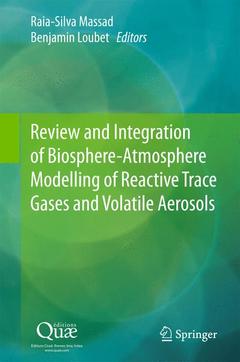Review and Integration of Biosphere-Atmosphere Modelling of Reactive Trace Gases and Volatile Aerosols, Softcover reprint of the original 1st ed. 2015
Coordonnateurs : Massad Raia Silvia, Loubet Benjamin

When considering biosphere?atmosphere exchange of trace gases and volatile aerosols, significant advances have been made both from an experimental and modelling point of view and on several scales. This was particularly stimulated by the availability of new datasets generated from improvements in analytical methods and flux measurement techniques. Recent research advances allow us, not only to identify major mechanisms and factors affecting the exchanges between the biosphere and the atmosphere, but also to recognize several gaps in the methodologies used in accounting for emissions and deposition in landscape and global scale models. This work aims at (i) reviewing exchange processes and modelling schemes, parameterisations and datasets, (ii) presenting a common conceptual framework to model soil-vegetation-atmosphere exchange of reactive trace gases and aerosols accounting for in-canopy transfer chemical interactions and (iii) discussing the key elements of the agreed framework.
Organisation and structure of the workshop
Objectives
Document structure
References
Section I: Review documents
Advances in understanding, models and parameterisations of biosphere-atmosphere ammonia exchange
Modelling atmosphere-biosphere exchange of Ozone and Nitrogen oxides
Introduction
Sources and sinks processes contributing to biosphere-atmosphere exchange
Turbulent transport and diffusion inside the canopy
Existing Models
Shortcomings and potential improvements of models
Data needed for model validations
Links to exchange of other reactive compounds and aerosols
References
Bidirectional exchange of volatile organic compounds
Introduction
Reduced VOC
Atmospheric oxidation products
Bidirectional VOC
References
Surface / atmosphere exchange of atmospheric acids and aerosols, including the effect and model treatment of chemical interactions
Introduction
Deposition of acids
Deposition of aerosols
Chemical interactions
Topical research questions to be discussed
Acknowledgements
References
Section II: Synthesis according to compounds
Modelling the air-surface exchange of ammonia from the field to global scale
Introduction
Development of improved NH3 process-based bi-directional exchange models
Uncertainty in processes and measurement needs
Conclusion and model integration
References
O3 and NOx exchange
Introduction
Product of the discussion
Areas of uncertainty
Conclusions
References
Bi-directional exchange of volatile organic compounds
Introduction
Current parameterizations in CTMs for reduced VOC and atmospheric oxidation products
Gaps and disadvantages of current parameterizations
The ideal model
Conclusion
References
Aerosol and Acid Gases<
Introduction
Products of the Discussion
Areas of Uncertainty
Conclusions
References
Section III: Synthesis according to model component
Gaseous stomatal exchange and relation to ecosystem functioning
Introduction
Key processes to account for in stomatal trace gas exchange models
Framework of a common conceptual model adapted to different compounds: Stomatal exchange
Research needs for future developments
Conclusion
References
Impact of leaf surface and in-canopy air chemistry on the ecosystem/atmosphere exchange of atmospheric pollutants
Introduction
Current status and knowledge gaps
Possibility of a common framework
References
Soil and litter exchange of reactive trace gases
Introduction
Products of the Discussion
Areas of uncertainty
Conclusions
References
In-canopy turbulence - State of the art and potential improvements
Introduction
Current parameterisations of in-canopy turbulence
Disadvantages of current parameterisations
Ways to improve parameterisations of in-canopy turbulence
The development of a conceptual in-canopy turbulence model that can be integrated into a chemical transport model (CTM)
Conclusions
References
A common conceptual modelling framework for reactive trace gases and volatile aerosols atmosphere-biosphere exchange in chemical transport models
General model requirements
The ideal model for each compound
Ammonia
Nitrogen oxides and ozone
Aerosol and acid gases
Volatile organic compounds (VOC)
Emerging common features in the modelling framework
A new paradigm of bi-directional dynamic exchange
Model components
Model structure and modularity
Links with external drivers and models
A first basis for a common framework
Conclusions and key challenges
Acknowledgement body>
Explains the current state of knowledge on biosphere-atmosphere exchange of trace gases and volatile aerosols
Offers a collection of scientific papers summarising the key issues associated with biosphere atmosphere exchange exchanges
Suggests approaches to developing a new modelling framework for biosphere atmosphere exchanges
Includes supplementary material: sn.pub/extras
Date de parution : 07-2015
Ouvrage de 235 p.
15.5x23.5 cm
Date de parution : 10-2016
Ouvrage de 235 p.
15.5x23.5 cm



